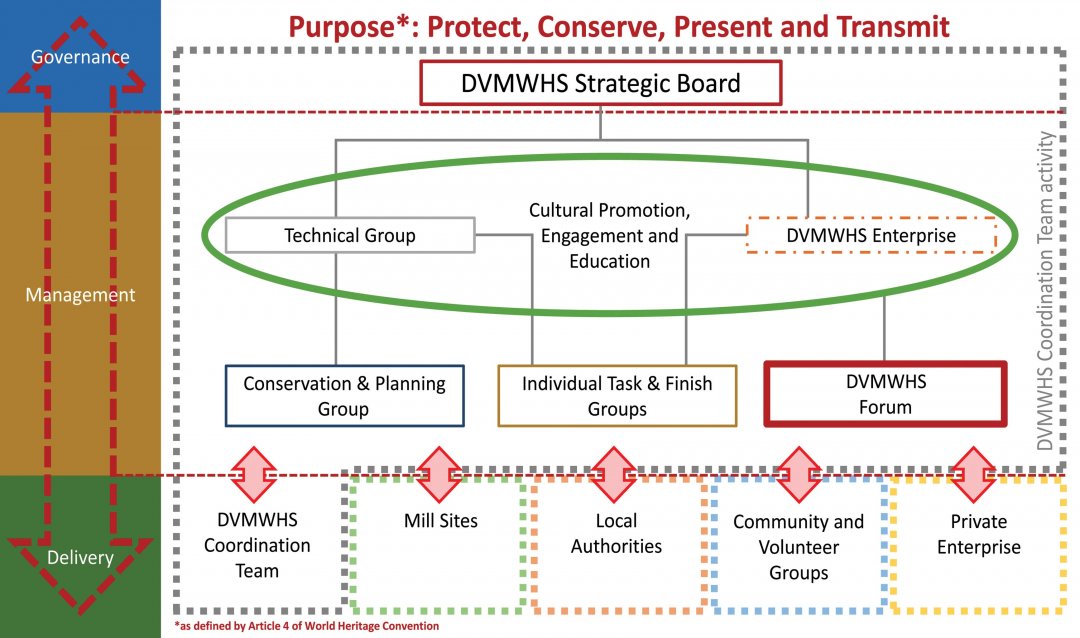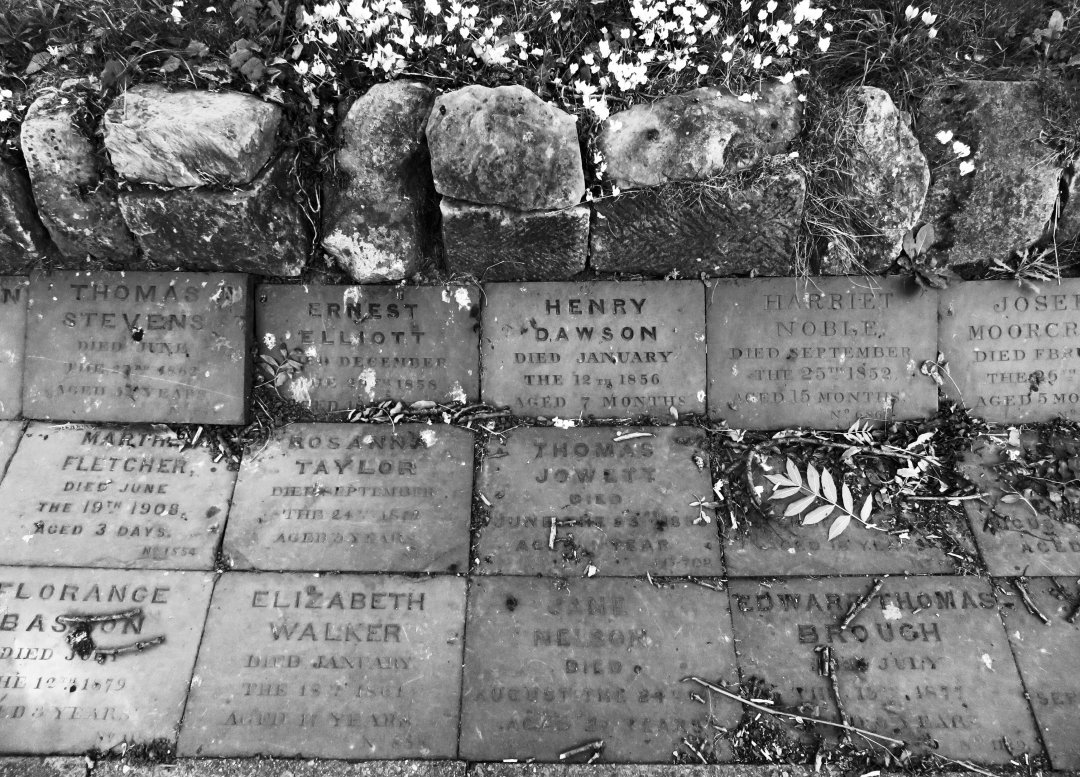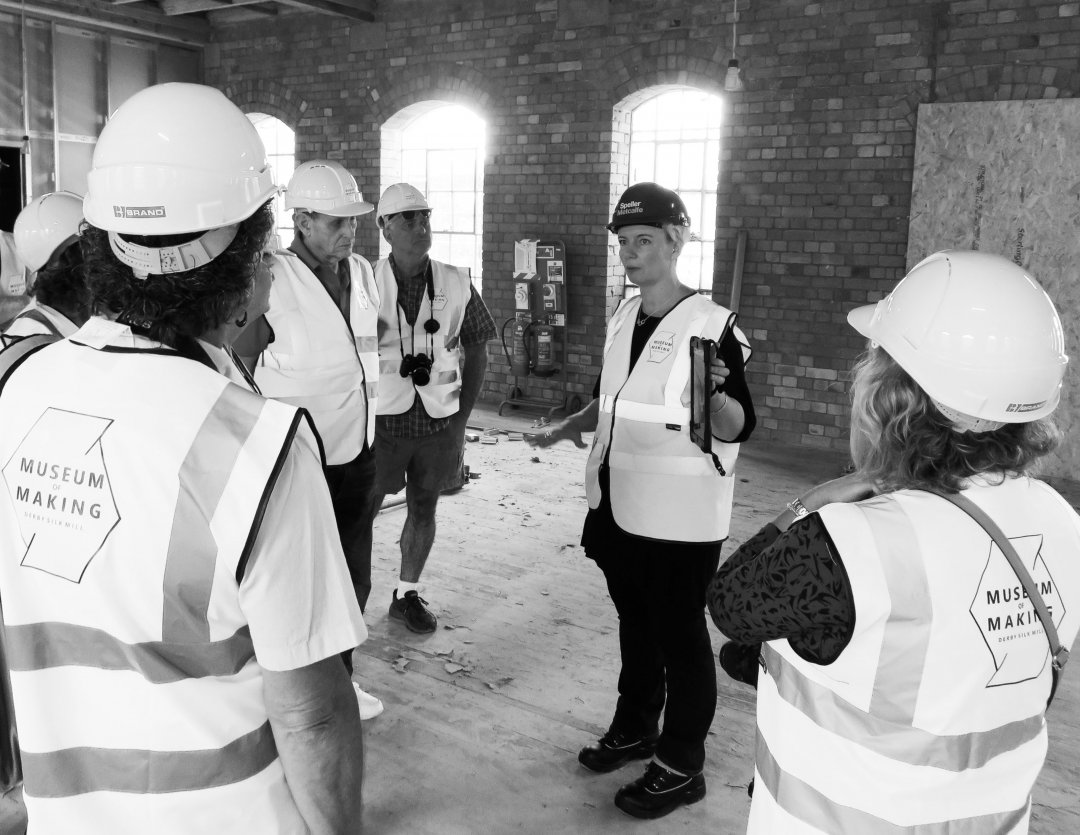Statutory administration for the Derwent Valley Mills World Heritage Site is shared by a number of local authorities and government agencies. The Management Plan provides the co-ordination mechanism for their administration of the Site.
Approximately two-thirds of the key properties, and the overwhelming majority of other buildings, are privately owned. It is therefore important that private owners are engaged with and, where appropriate, help deliver the Management Plan.
The Derwent Valley Mills World Heritage Site Partnership is responsible for overseeing the production of the Management Plan and for coordinating its implementation on behalf of Her Majesty’s Government.
The Partnership is a coalition of interested bodies that is formally represented via the management structure identified below.
Research undertaken during 2019 identified a number of changes to the governance and management structure that are required in order to reflect changes to the political and economic context in which the site operates, the development of the partnership over time, and to enable it to develop and adapt further over the lifetime of this Management Plan.
The primary changes proposed are as follows:
- The Steering Group will operate as a high level Strategic Board that:
– ensures that sufficient resources are available to maintain the Outstanding Universal Value of the Site and,
– monitors the delivery of the actions identified in the Management Plan.
It is referred to on the organisation chart and the following text as the DVMWHS Strategic Board.
- A Technical Group will be established composed of the officers of partner local authorities and public agencies, staff of partner private businesses and representatives of partner community organisations.
- Over the period of this Management Plan work will be undertaken to explore the viability of establishing a new not-for-profit organisation (e.g. a Community Interest Company, Charitable Incorporated Organisation or charitable company). This organisation is referred to in the following text as DVMWHS Enterprise.
The resourcing of the coordination team needs to reflect the workload associated with:
- servicing the structure identified in the Organisation Chart below,
- delivery of Management Plan actions for which it is responsible,
- coordinating the delivery of partners, and
- supporting the establishment of the new DVMWHS Enterprise.

10.1 Governance
The diagram above shows the structure of the DVMWHS Partnership. The left hand side shows which elements of the Partnership are responsible for Governance, Management and Delivery. Obviously, there will be some fluidity between these responsibilities and the overlying ‘dashed’ red arrow depicts this movement. The green ‘lozenge’ in the middle of the diagram represents the Cultural and Engagement activities that are a requirement of UNESCO, delivery of which needs to be overseen and managed by the Technical Group and DVMWHS Enterprise.
10.1.1 The Strategic Board
Overall governance of the Partnership will be provided by the Strategic Board.
The primary functions of governance in this context are:
- Foresight:
– to hold the purpose, values and culture of the partnership and ensure it is commensurate with UNESCO.
- Strategy:
– to ensure the Management Plan is in place and being delivered to fulfill HM Government’s commitment to UNESCO.
- Management:
– To ensure the structures and resources required to deliver the Management Plan are in place.
- Accountability:
– to the wider partnership, DCMS and UNESCO for the delivery of the commitments set out in the Nomination Document, delivery of the Management Plan and maintenance of the Outstanding Universal Value of the Site.
The membership of the Strategic Board will be comprised of senior representatives (CEOs, Leaders, Senior Managers) from:
- Derbyshire County Council
- Derby City Council
- The Local Planning Authorities:
-Amber Valley Borough Council
-Derbyshire Dales District Council
-Erewash Borough Council
- National Lottery Heritage Fund
- D2N2
- Marketing Peak District and Derbyshire
- Visit Derby
- Historic England
- Natural England
- University of Derby
- Arts Council England
- ‘Green’ business
- Business x 2
- DVMWHS Enterprise (once established)
The Strategic Board will meet annually in late September/early October when local authority and public agency budgets are being set. The Strategic Board members will also be encouraged to attend the Partnership Forum meeting in March/April (see 10.2.4 below).
Strategic Board members will be expected to be advocates of the DVMWHS and champion its purpose and objectives (see Section 11 and Part B)

10.2 Management
10.2.1 The Technical Group
A new Technical Group will be established to bring together officers of partner local authorities and public agencies, staff of partner private businesses and representatives of partner community organisations, who are individually and collectively responsible for the delivery of actions identified in the Management Plan.
The purpose of the group will be to share, coordinate and report on progress with respect to the delivery of actions, updating the Action Plan (see Executive Summary, Part D) accordingly.
This group will also act to identify available resources, gaps, challenges and opportunities with respect to the Management Plan’s delivery.
It will meet twice a year, in February/March and September and report both to the Strategic Board and the Partnership Forum (see 10.2.3).
Membership of the Technical Group will be comprised of staff and officers involved in the delivery of Management Plan actions and any associated projects or programmes of work that are relevant to Management Plan delivery.
This will, not exclusively, include:
- Local Authority Officers
– Promotion/economic regeneration
– Transport
– Conservation
- Key Destination Sites (staff and/or trustees)
- Significant DVMWHS related enterprises/operators
– e.g. Birdswood, Derbyshire County Council’s Countryside Service
- The Derwent Valley Trust
- Town and Parish Councils
- Community Rail Partnership and other transport groups
- Community representatives and volunteers
- Environment and sustainability representatives
– Natural England
– Environment Agency
– Derbyshire Wildlife Trust
- Historic England
- ICOMOS UK
- D2N2
- Derbyshire Historic Buildings Trust
- DVMWHS Educational Trust
- Learning and education organisations
- Health and wellbeing organisations
10.2.2 DVMWHS Enterprise
Over the period of this Management Plan work will be undertaken to explore the viability of establishing a new not-for-profit organisation (e.g. a Community Interest Company, Charitable Incorporated Organisation or charitable company), to be called ‘DVMWHS Enterprise’. This body would enable the key sites to work more collaboratively and with more freedom to grasp opportunities (particularly promotional) when they arise.
It is envisaged that the ‘directors’ of this entity will be representatives of the key destination sites and other like-minded attractions.
If DVMWHS Enterprise is successfully established, and proves to be viable, it is hoped that it will eventually contribute to the costs of the Coordination Team and cultural activity in the DVMWHS. Beyond the period of this Management Plan, it may be possible for the coordination team to migrate from Derbyshire County Council to DVMWHS Enterprise, if it could be proven that the coordination work would be sustained and UNESCO’s expectations for the Derwent Valley Mills World Heritage Site met.
The full scope and operation of this entity is not yet fully formed but all of its activities will need to be in line with UNESCO objectives and it will report to the Strategic Board. Funding to help develop and realise this body and its potential will need to be secured early in the life of the Management Plan. Discussion will also be needed on how the Enterprise model can be stress tested and its start-up funding requirements identified and fulfilled.
10.2.3 Working Groups
In addition to the Technical Group the following working groups will be retained, established or developed:
- Conservation and Planning Group
– The current panel membership and terms of reference will be retained.
- Economic Development
– Task and finish groups will be established to address specific actions in the Management Plan with respect to economic development e.g.
o the development of the Belper Mills complex
o improving connectivity between the railway stations and key sites
o the enhancement of hydro electric power in the valley
- Cultural Engagement
– Working groups will be established to explore:
o developing engagement materials and opportunities for transmitting an understanding of OUV to the widest possible range of audiences;
o the potential for the new not-for-profit vehicle DVMWHS Enterprise to contribute to the DVMWHS engagement;
o site-wide arts and cultural activities for residents and visitors;
o recruitment and management of volunteers;
o the coordinated delivery of programmes of community engagement;
o the development of learning resources, materials and activities for use within and beyond the site;
o the potential for using and enhancing collection and archives to better interpret and understand the OUV of the DVMWHS.

10.2.4 DVMWHS Forum
The Derwent Valley Mills World Heritage Site Forum provides a voice and mechanism for the widest range of interested partners. It gives them the opportunity to engage with the World Heritage Site and network with partners. It will meet once every two years.
10.3 Delivery
10.3.1 Actions
Delivery of the Management Plan is a collective endeavour delivered by a large number of partners. ‘Lead’ and ‘Involved’ organisations have been identified against each of the actions in the Management Plan.

10.3.2 Coordination
Coordination of the delivery of the Management Plan is undertaken by a core team, based at County Hall, Matlock. This team currently consists of:
- Heritage Co-ordinator (full time)
- Development Co-ordinator (full time)
- Business Services Assistant (half time)
In addition to the delivery of a number of key actions in the Action Plan they are also responsible for the support of:
- The Strategic Board
- The Technical Group
-Conservation and Planning Group
- The following task and finish groups:
-Economic development
-Culture, engagement and education
-Learning, research and collections
- The Partnership Forum
The team is managed by the Head of Conservation, Heritage and Design at Derbyshire County Council and hosted by Derbyshire County Council.
Learning and education support is currently provided by Derbyshire County Council’s Environmental Studies Service. Learning and education are a requirement of UNESCO. A reduction in the coordination team’s core budget resulted in the deletion of the Learning Coordinator post in 2014. The Business Services role was reduced to part-time in 2017; at the same time, the Director post was deleted and responsibilities passed to the new role of Head of Conservation, Heritage and Design.
From January 2018 to December 2020, two further officers have been employed to deliver the Derwent Valley Mills World Heritage Site Great Place Scheme, funded by the National Lottery Heritage Fund and Arts Council England. The Great Place Scheme is a programme of activities, using the Derwent Valley Mills’ industrial heritage and spirit of innovation and making, to inspire people to connect with the culture and heritage of this historically significant place.
Additional coordinator resource will be required for the period of this Management Plan, to help establish the DVMWHS Enterprise, and appropriately address UNESCO’s learning and education requirements.

10.4 Funding and resources
The coordination team is currently funded by financial contributions from Derbyshire County Council, Derby City Council, Amber Valley Borough Council, and Derbyshire Dales District Council. However financial contributions have decreased by 38% since 2015/16.
Additional in-kind support is provided by Derbyshire County Council. This consists of:
- Time that the Head of Derbyshire County Council’s Conservation, Heritage and Design Service allocates to the World Heritage Site e.g. Coordination Team management, Management Plan development and appearing as expert witness at planning appeals.
- Conservation and planning advice from officers within the Conservation, Heritage and Design Service.
- Work undertaken by Derbyshire Environmental Studies Service relating to learning and education.
The current levels of resource are not sufficient to deliver the commitments of this Management Plan and develop a viable delivery infrastructure, i.e. DVMWHS Enterprise.
Additional financial resources will be required to provide additional coordinator resource to deliver the Management Plan, particularly objectives related to learning and engagement and investigating the development of the DVMWHS Enterprise.
Page 158 of the DVMWHS Nomination Document (2001) sets out the commitment made by the Partnership members towards staffing at the time of inscription: “The authorities and agencies engaged with the nomination are committed to continued co-operation and collaboration to provide an effective professional, technical and administrative regime for fulfilling the objectives outlined in the Management Plan.” It continues: “A substantial commitment of staff resources to prepare the nomination has been made by Derbyshire County Council, Derby City Council, the district councils and English Heritage [now Historic England]. Each are committed to the continuing provision of staff time and financial resources to ensure the good stewardship of the nominated site.”
The commitments HM Government made to UNESCO in the Nomination Document still stand.
In the longer term the expectation is that, if the DVMWHS Enterprise is viable, it will be able to secure additional external grant funding and generate trading income from its activities. This will provide new sources of revenue to support the delivery of elements of future Management Plans. However, in the short term, the Strategic Board will need to investigate securing additional funding to deliver this Management Plan’s aims, objectives and actions by 2025.
